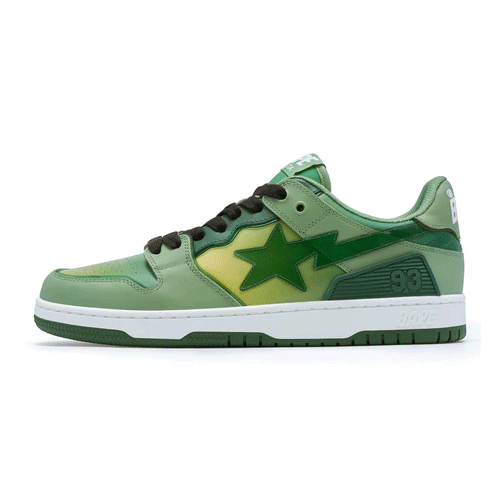In the world of streetwear and sneakers, few silhouettes have left as lasting an impression as the Bapesta. From its controversial beginnings to its cemented place in sneaker culture, the Bapesta is more than just a shoe — it’s a statement. If you’re a fashion enthusiast, sneaker collector, or someone diving into streetwear, understanding the Bapesta’s legacy is essential.
The Origins of Bapesta: A Bold Vision from Nigo
The Bapesta was introduced in the early 2000s by A Bathing Ape (BAPE), the legendary Japanese streetwear brand founded by Nigo in 1993. Inspired heavily by hip-hop culture and American fashion, BAPE quickly gained cult status in Japan before expanding globally.
When the Bapesta launched, it immediately drew comparisons to the Nike Air Force 1. The similarities were striking: same silhouette, sole pattern, and overall shape. But Nigo wasn’t trying to create a counterfeit — he was crafting a cultural remix. Instead of Nike’s iconic swoosh, BAPE replaced it with the star-shaped “STA” logo, often outlined in metallic or bold contrasting colors. The materials used were flashier, the colors louder, and the branding unmistakably BAPE.
While some called it a knock-off, others saw it as genius. In the early 2000s, remix culture was everywhere — in music, fashion, and art. The Bapesta wasn’t just copying; it was innovating within a global streetwear dialogue.
How the Bapesta Took Over the Hip-Hop World
Part of the Bapesta’s meteoric rise can be attributed to its early adopters in the hip-hop scene. During a time when sneakers began defining status and identity, artists like Pharrell Williams, Kanye West, Lil Wayne, and the Clipse regularly sported Bapestas.
One of the most iconic moments came when Pharrell and Nigo launched the Billionaire Boys Club (BBC) and Ice Cream, which further solidified the cross-cultural fusion of Japanese fashion and American music. Bapestas became a visual trademark of Pharrell’s style, often customized in bright colors or exclusive designs.
In 2007, Kanye West released a Bapesta collaboration featuring his “Dropout Bear” artwork. For many fans, this was one of the earliest and most memorable Kanye sneaker collabs, long before the Yeezy line took over the industry.
The Bapesta wasn’t just another sneaker — it became a symbol of elite streetwear knowledge. Wearing them meant you were in the know.
Bapesta’s Signature Aesthetic: Loud, Luxurious, and Limited
What makes a Bapesta immediately recognizable is its bold colorways, glossy patent leather, and signature STA logo. Over the years, BAPE has released countless versions of the shoe — from solid pastels to wild camouflage prints and rare collaborations with brands like Marvel, SpongeBob, and even Coach.
The appeal lies in its unpredictability. A new drop could mean a minimalist monochrome look or a psychedelic mashup of neons and metallics. This level of design experimentation, paired with limited releases, drives the Bapesta’s hype.
Collectors often compare Bapestas to luxury art. They’re not just sneakers; they’re wearable pieces of pop culture. Some limited pairs have fetched thousands of dollars on resale platforms, further cementing their high-status allure.
The Controversy: Innovation or Imitation?
It’s impossible to talk about the Bapesta without addressing the controversy surrounding its resemblance to the Air Force 1. Nike never officially licensed the design, and yet, for many years, the Bapesta continued to be sold and celebrated.
In Japan, where BAPE was primarily based at the time, the legal implications were less clear-cut than in the U.S. Nigo always positioned the shoe as a reinterpretation rather than a reproduction. Still, many in the sneaker world debated its legitimacy.
Today, this controversy feels almost secondary to its cultural impact. The Bapesta helped usher in an era where brands like Supreme, Palace, and Off-White would also blur the lines between homage and innovation.
Bapesta in the Modern Sneaker Era
As fashion trends cycle and nostalgia reigns supreme, the Bapesta has made a major comeback. BAPE, now under new leadership since Nigo’s departure, has revitalized interest in the brand’s classics. New Bapesta drops, especially collaborations, sell out quickly and often trend across social media.
Luxury fashion houses have taken note, with brands like Louis Vuitton and Dior launching sneaker lines that clearly echo the streetwear aesthetic pioneered by brands like BAPE. In many ways, the Bapesta helped lay the groundwork for today’s high fashion x streetwear collaborations.
Newer collaborations with artists like Kid Cudi and ASAP Rocky keep the silhouette fresh and relevant. Meanwhile, the resale market continues to thrive, with older models becoming prized pieces for vintage collectors.
Styling the Bapesta: How to Rock It Today
Despite its bold design, the Bapesta is surprisingly versatile when styled correctly. The key is to let the sneaker shine. Pair a bright pair of Bapestas with neutral outfits — think oversized cargos, clean hoodies, or a minimalist jacket.
For a full streetwear look, go for layering. Think graphic tees, vintage denim, and accessories like crossbody bags or snapbacks. Bapestas also pair well with more tailored pieces, creating a contrast that’s very on-trend in today’s fashion scene.
Whether you’re dressing down for a casual day or making a statement at a fashion event, a well-styled pair of Bapestas can elevate your entire outfit.
The Future of Bapesta: A Timeless Streetwear Staple
Looking ahead, the Bapesta’s legacy is secure. With decades of history, legendary collaborations, and a fanbase that spans continents, it remains a core symbol of what streetwear is all about — individual expression, cultural remixing, and fearless creativity.
In an industry that moves fast and forgets even faster, the Bapesta has proven its staying power. Whether you’re a longtime collector or just discovering the brand, investing in a pair of Bapestas means owning a piece of streetwear history.
Final Thoughts: More Than Just a Sneaker
To understand the Bapesta is to understand the intersection of music, fashion, and identity. It’s not just about the shoe itself but what it represents: a movement, a moment, and a mindset.
As the world of streetwear continues to evolve, one thing remains clear — the Bapesta will always have a place on the shelves of sneakerheads and in the hearts of fashion lovers around the globe.




